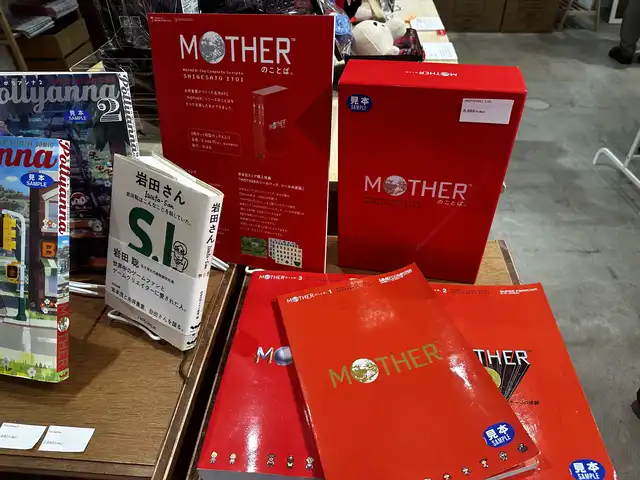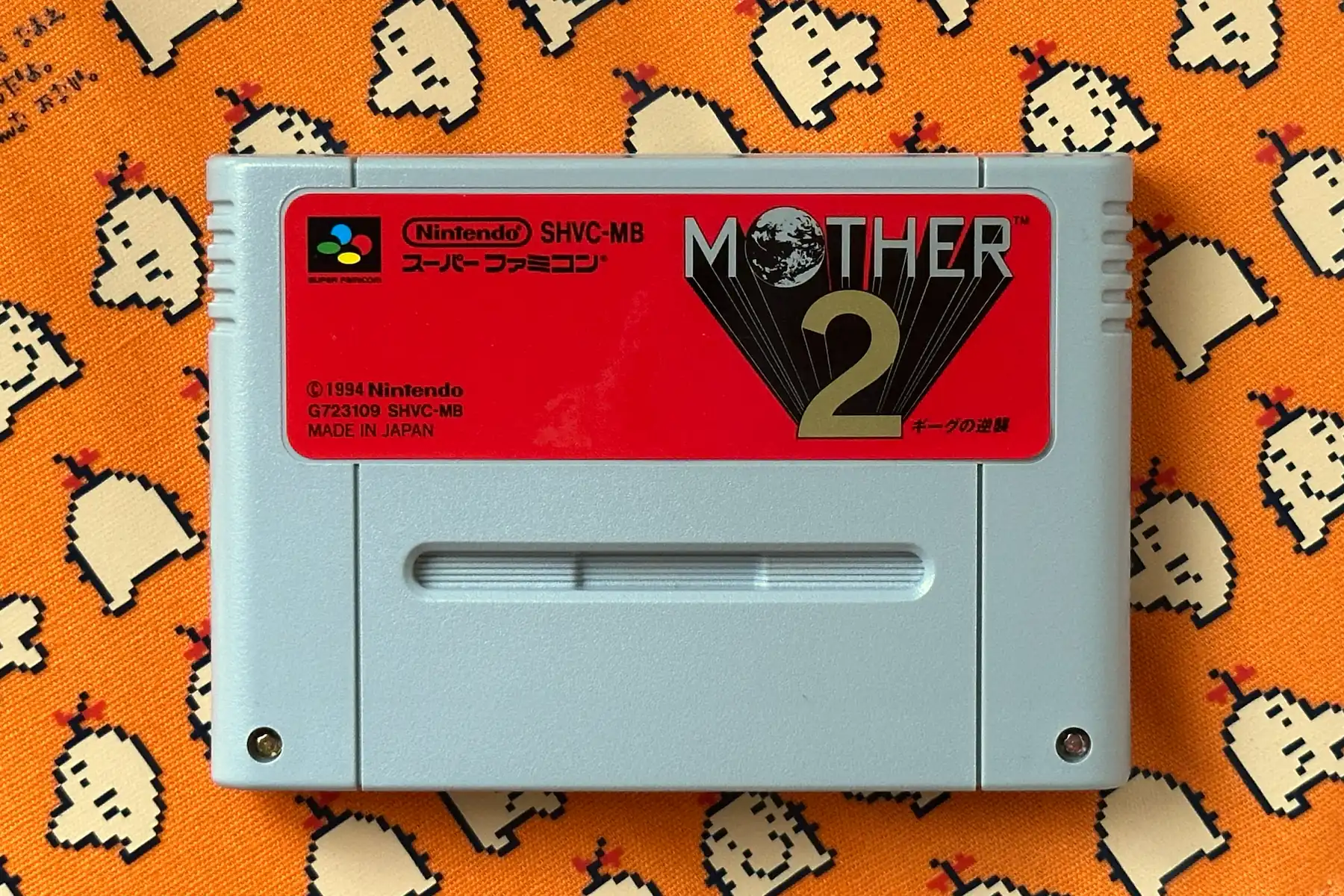
Mother 2 - 30th Anniversary
Today marks the 30th anniversary of Mother 2 , a game that was released on August 27, 1994, for the Nintendo Super Famicom in Japan. This game has profoundly shaped my formative years, compelling me to write this blog post to share my thoughts and memories.
This post is a random collection of thoughts on what I love about Mother 2. I strongly recommend experiencing the game yourself before diving into this post—the time investment is totally worth it.
Table of Contents
What is Mother 2?
Mother 2 (Full Japanese title: MOTHER2 ギーグの逆襲, MOTHER2: Gyiyg no Gyakushuu, which translates to Mother 2: Gyiyg Strikes Back), is an extravagant turn-based JRPG, brainchild of Shigesato Itoi—a multitalented Japanese copywriter, essayist, actor, and designer known for his unique storytelling and creative approach to game development. Developed by Ape Inc. and HAL Laboratory and published by Nintendo.
Mother 2 stands out for its modern-day setting, captivating story, and profound themes. Visiting hotels, hospitals, burger shops, and stores, and withdrawing/depositing money from ATMs felt fresh and whimsical for a JRPG back in the day.
WARNING
- This article contains spoilers for Mother 2/EarthBound and the entire Mother series.
Mother 2 & I
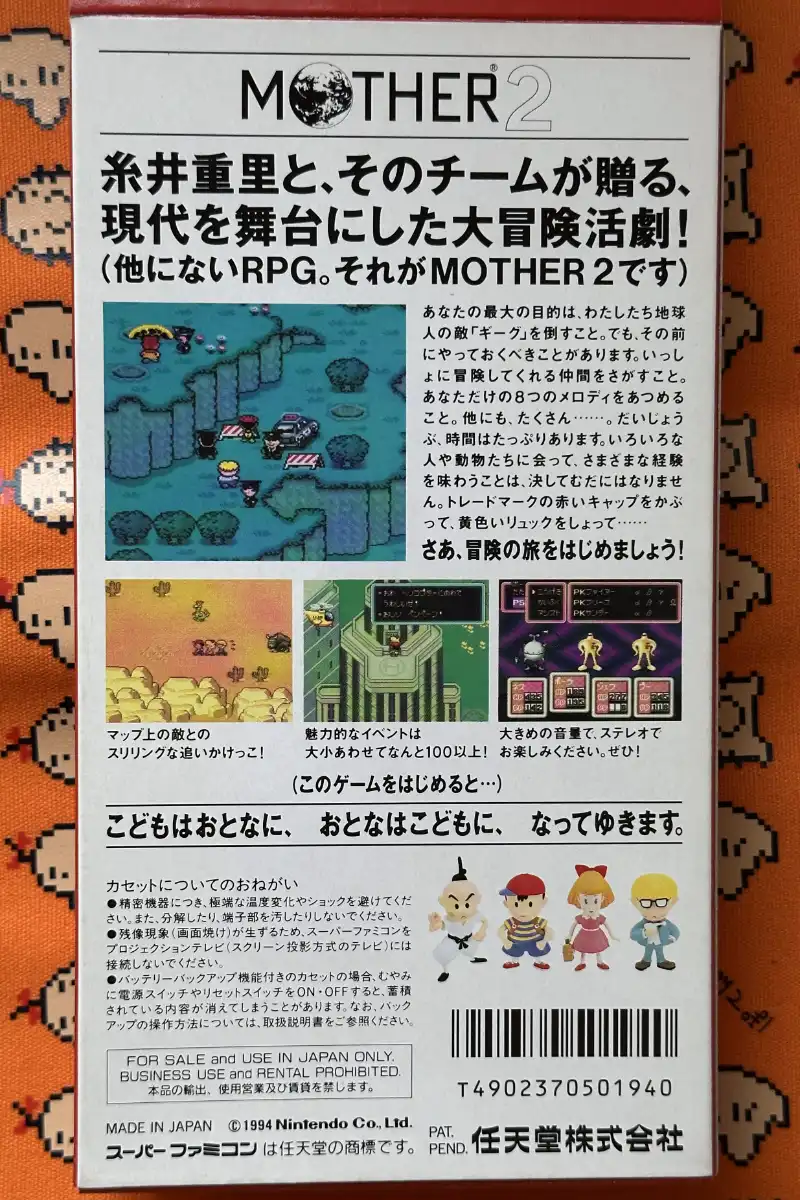
I played tons of JRPGs during my youth, but nothing impacted me as profoundly as Mother 2, which changed how I see myself and the world.
My first encounter with Mother 2 (or EarthBound as it was titled in the West) was through a monthly SNES magazine
from my childhood. It was love at first sight. I vividly remember a two-page preview of EarthBound, detailing the journalist’s experience with the demo at CES 1995, complete with screenshots. Unlike other JRPGs with fantasy worlds and typical heroes, EarthBound featured 12-year-old kids in a modern setting inspired by contemporary North America. Instead of your average fantasy world with warriors and sorcerers fighting dragons or magical clowns riding magical armors, this game presented a whimsical adventure in an everyday setting. The brief report fueled my imagination, sparking an obsession that lasted for months as I eagerly awaited more information in subsequent issues. This was during my pre-internet days, so my mind, gaming magazines, and endless speculations with friends were all I had.
Unfortunately, Mother 2 was never released in Europe, and I didn’t experience the game until a few years later when an older friend introduced me to alternative ways to play SNES games.
I have incredibly fond memories of playing Mother 2. Even my sister got into it at one point, and I vividly remember that she managed to beat the game before I did because she figured out how to defeat the final boss first. Nothing but good memories all around—this game brings me back to better days.
But enough nostalgia. What exactly is Mother 2, and why is it so beloved by players worldwide?
Mother 2’s Premise (in a Nutshell)
Set in 199X, Mother 2 follows Ness, a 12-year-old boy living a typical suburban life with his mom, sister, dog, and absentee dad. One night, a meteorite crashes near his house, waking him up. Armed with a trusty baseball bat, his dog, and his neighbor Pokey, Ness ventures out to investigate.
At the meteorite, a flash of light reveals a talking insect named Buzz Buzz. Buzz Buzz has traveled 10 years into the past from a future devastated by a malevolent entity called Giygas. He reveals that a prophecy foretells that four kids will defeat Giygas with the power of friendship, and Ness is one of them. Unfortunately, Buzz Buzz is killed in a freak accident shortly after delivering this message.
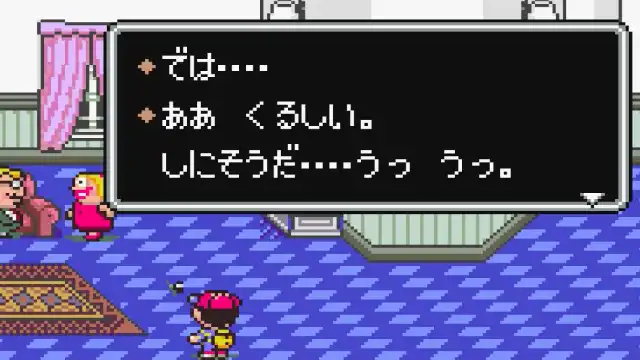
In its dying words, Buzz Buzz explains that Ness must find 8 magic locations and record their melodies into a Sound Stone to defeat Giygas. As Giygas’s influence grows stronger, Giygas’s army will stop at nothing to thwart Ness. Now alone (for now), Ness must gather the courage to fight Giygas, collect the 8 melodies, and save the world.
The Art of Mother 2
The art of Mother 2 immediately stands out as one of its most respected and imitated aspects. This colorful, cheerful, beautiful pixel art world is one in which I could lose myself for hours and just feel at home. Mother 2’s design was unlike anything people in the 90s were used to. The character design is endearing—a mix between the Peanuts and a Japanese spin on it. Everything is designed in an interesting and extravagant way, starting with the four protagonists: Ness, Paula, Jeff, and Poo. They don’t talk much during the game (Ness is completely silent), but still, each one is so well-designed that you can understand their roles and personalities just by looking at them. Ness, the everykid, tries to be courageous and save the world with his lovely red baseball cap, striped shirt, and yellow backpack. Paula is the intelligent, gentle, and strong-willed member of the group. Jeff is the boy genius with a high IQ but super shy. Poo is the dedicated martial artist on a quest for self-improvement.
Secondary characters and enemy creatures also exude charisma, like the quirky Mr. Saturns or Ego Orb (an absolute favorite of mine—its design is just brilliant).
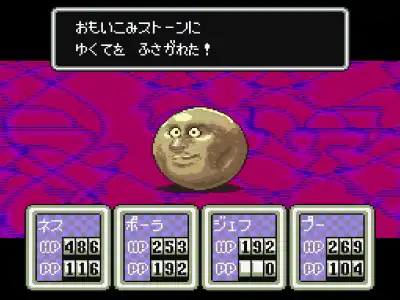
And who could forget Bubble Monkey and Tessie? They are totally adorbs together! 💖🫶

Each environment is distinct (even tho the first three towns may appear similar), and the colorful, lively pixel art perfectly conveys the intended mood. The isometric perspective pixel art makes the world of Mother 2 look delightful.
If it wasn’t clear enough, I love everything about Mother 2’s style and visual identity—everything is perfect.
The Music of Mother 2
Mother 2’s music slaps hard. As in Mother 1, the music was handled by Keiichi Suzuki and Hirokazu Tanaka (yes, that Chip Tanaka). This time, the magic duo was even more powered up with the SNES sound chip. Mother 2’s soundtrack range is amazing, from happy, horror, jazz, surf, blues, and more. The theme song is immense and will be forever etched in my mind.

The sound effects are equally memorable—there’s nothing more satisfying than the smash sound when you hit an enemy with your baseball bat. One thing I love about the battle themes is that you can tell the gravity of the encounter ahead of you by the tone of the battle theme playing, which is a great way to hint to the player, especially when reaching new areas.
The Writing of Mother 2
Mother 2’s writing is both humorous and heartfelt, filled with clever dialogue
and quirky characters. The game effectively uses popular sci-fi tropes like meteorites falling on Earth, the Loch Ness Monster, Stonehenge, pyramids, aliens kidnapping people, and more. These familiar contemporary sci-fi elements help reinforce the theme of fighting aliens from outer space.
The NPCs are full of jokes and cultural references (Yellow Submarine, anyone?), adding an extra layer of charm and wit. I love how each city’s NPCs genuinely thank you from the bottom of their hearts, making you feel appreciated and accomplished.
The game starts funny, with jokes so great they make me crack smiles, but it becomes a story of sadness and tears by the end.
Mother 2’s Battle System
Mother 2’s battle system is classic and simple turn-based JRPG style, but it stands out with its unique charm and personality. The battles are presented in a first-person view, allowing players to see the world from the perspective of the characters. The game uses HP (Hit Points) and PP (Psychic Points, basically Magic/Mana Points in other games) to manage health and special abilities, respectively.
Despite its simplicity, the battle system is incredibly fun. The mechanics include smashes, misses, and enemies performing goofy actions or exhibiting weird status effects, making each encounter feel lively and unpredictable. The storytelling in the battle textboxes adds even more flair to the world, providing context and humor that enhance the overall experience.
One of the game’s clever mechanics is that dying doesn’t result in losing progress. Instead, you only lose half of the money in your pockets (pro tip: always keep most of your money in the ATM when not needed), which encourages experimentation and reduces frustration while still maintaining a sense of risk. This design choice adds a strategic layer to managing resources.
The system’s high-stakes, risk-reward nature keeps battles engaging, with charming dialogues and dynamic scenarios that make even routine encounters enjoyable.
Rolling HP
Mother 2’s battle system is simple but addictive, with a unique twist that makes encounters more gripping. In most JRPGs, when a party member takes damage, it’s subtracted immediately. If current HP <= damage received, the party member dies instantly—okay, okay, I know they’re not really dead, just unconscious, but still…
In Mother 2, damage isn’t subtracted immediately. Instead, the HP meter rolls down gradually, creating tense situations where quick reflexes and split-second decisions matter. Do you heal someone before their HP drops to zero, or do you finish the battle before the full damage takes effect?
The rolling HP meter allows you to save party members from fatal damage if you act fast. Battles, even boss battles, don’t drag on if you fight efficiently. The rolling meter is more valuable when you have more HP to lose because you can heal significant damage before it fully registers. In the early game, when HP is low, the rolling meter can be too fast to manage effectively. Additionally, some skills can still insta-kill you, so never lower your guard, regardless of your HP pool.
The World of Mother 2
Mother 2 masterfully crafts a world that’s both inviting and unsettling, seamlessly blending lighthearted charm with unexpectedly darker themes.
Every environment in the game is beautifully crafted, with careful attention to detail. The pixel art, color palettes, and music work in harmony to create a distinct atmosphere for each location. The NPCs and their quirky dialogues further enrich the world, making it feel lived-in and relatable.
The world is full of personality, making exploration a joy in itself. You’ll encounter chill, homey towns like Onett—Ness’s hometown—where life seems simple and joyful, juxtaposed with disturbing places like Happy Happy Village. The game’s atmosphere is truly captivating, managing to evoke a range of emotions as you progress through the narrative.
As a road-trip RPG, Mother 2 takes you and your party on a grand adventure, traversing a diverse landscape filled with both familiar and fantastical elements. From the snowy expanse of Winters to the sun-drenched beaches of Summers, each location is distinctly rendered, showcasing the game’s vibrant pixel art and memorable NPCs. The bustling metropolis of Fourside offers a stark contrast to the quaint towns you’ve encountered thus far, while the mysterious Deep Darkness, Tenda Village, and the Lost Underworld test your courage and resilience. And then there are the truly otherworldly places like Saturn Valley, Magicant, and the Cave of the Past, each leaving an indelible mark on your journey.
Wandering through Mother 2’s towns, even without a clear objective, is a pleasure. The game rewards curiosity and invites you to get lost in its unique world. I always find myself smiling at the silly conversations, marveling at the imaginative landscapes, and feeling a sense of wonder.
Let’s take a closer look at some of my absolute faves in the whole game:
Saturn Valley
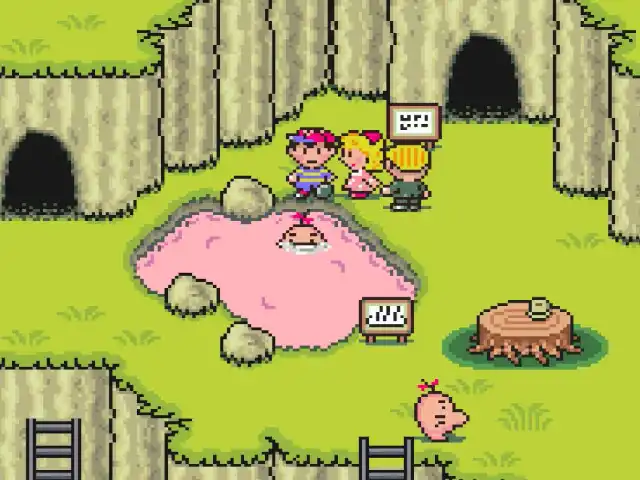
Home of the incredibly charming and unassuming Mr. Saturns. The atmosphere in Saturn Valley is peaceful, a true place to take a break from the adventure—and the game acknowledges that by including hot springs for recovering from debuffs and a coffee break, which is a chill cutscene. Mr. Saturns are a race of very peaceful and quirky beings with a distinct way of speaking, using unique and charming fonts for their text boxes. Mr. Saturns are so nice that the hotel and doctor services are free to use (but not the shop!). Dr. Saturn patches you up for free. Mr. Saturns are pure of heart and innocent souls; they don’t need money.
Saturn Valley will be visited multiple times as Mr. Saturns play a large role throughout parts of the game—they later help Dr. Andonuts and Apple Kid build the Phase Distorter, a time machine used at the end of the game.
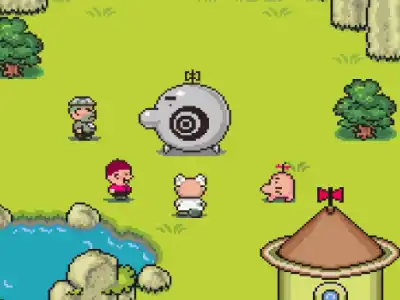
Saturn Valley’s architecture and aesthetics vastly differ from the towns visited so far. Each time I replay Mother 2, reaching Saturn Valley is a milestone to celebrate. The place brings nothing but good memories to me, memories of a carefree past that feels like a lifetime ago.
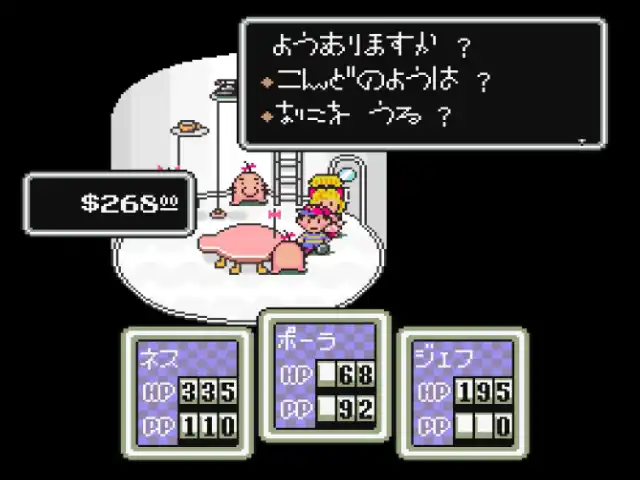
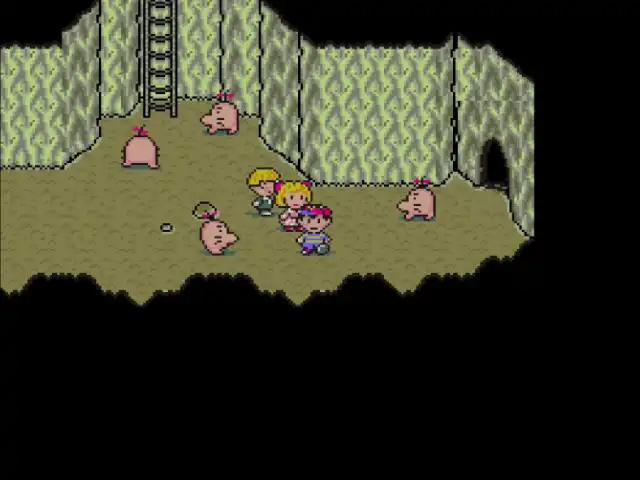
Moonside
Ness and Jeff find themselves in Moonside while investigating the mysterious Mani Mani Statue in Fourside. This statue creates a twisted illusion of Fourside, known as Moonside, pulling them into a surreal, neon-lit version of the city.
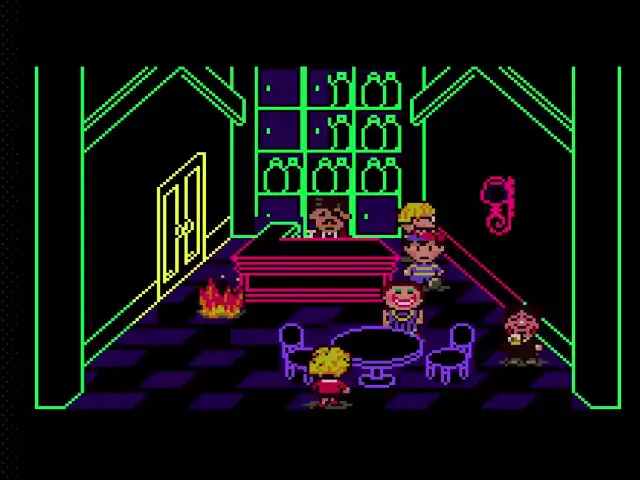
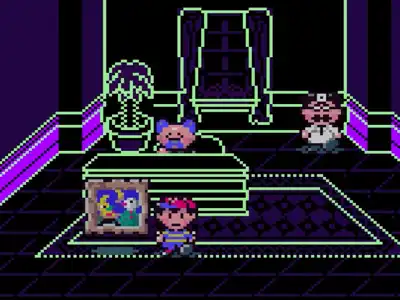
Moonside is a feast for the senses, with its vibrant color palette and unique visual style. The neon colors and abstract art give it an otherworldly feel that stands out sharply from the rest of the game. It’s a place where everything is opposite, creating a disorienting yet fascinating experience. The reverse speech of the inhabitants adds another layer of surrealism.
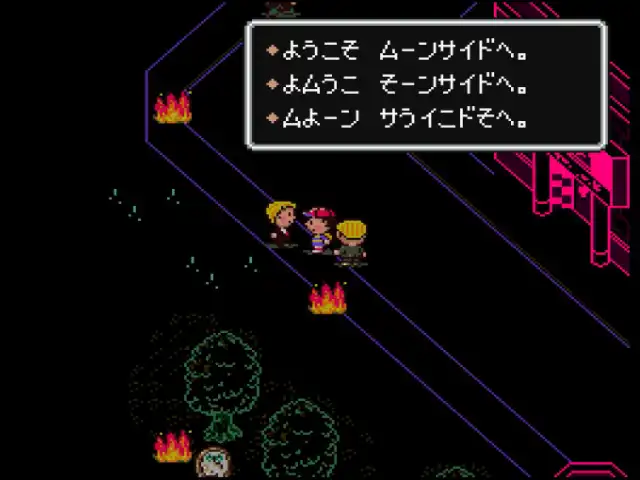
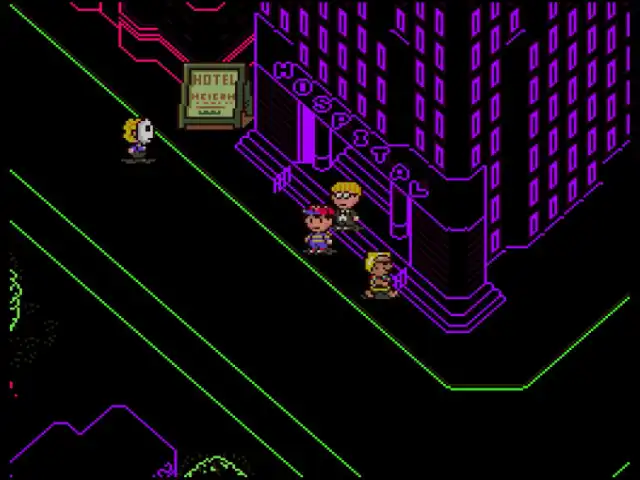
While I wish it was longer, Moonside leaves a lasting impression with its unique atmosphere and the sheer creativity of its design, despite its short duration.
Stoic Club
The world-famous Stoic Club offers a unique retreat for thinkers and pseudo-philosophers alike. The club’s minimalist interior design, featuring a rock on display, sets the stage for the intellectually curious characters you encounter here.

The club is filled with self-important pseudo-intellectuals who engage in deep, meaningless conversations about the essence of existence and the profound nature of art. The dialogue here is deliberately obtuse and hilariously nonsensical, poking fun at the often superficial nature of such gatherings.

Club Stoic isn’t just a place but a statement on the isolation and absurdity often found in intellectual elitism. This location exemplifies the game’s unique humor and its ability to satirize real-world social dynamics, wrapped in the absurd, offering dialogues that provide not only humor but also a subtle commentary on society—or is it? Sometimes, the line between satire and reality becomes so blurred that truth can lie in the satire itself.
The Dungeon Man
The Dungeon Man, once a dungeon lover known as Brick Road, has turned himself into a living dungeon with a hand from Dr. Andonuts.
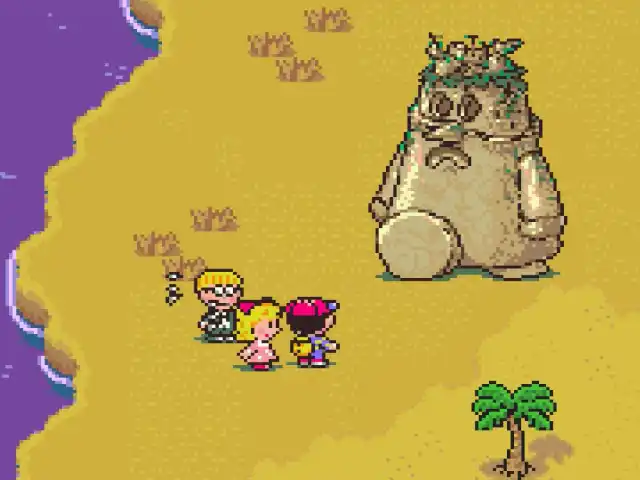
Navigating through the Dungeon Man dungeon is filled with humor and charm. The dungeon design parodies traditional RPG dungeons with winding paths, dead ends, and cleverly placed obstacles, making it a fun and nostalgic experience for RPG enthusiasts. Despite the usual challenges, the enemies here are not overwhelmingly difficult, allowing players to enjoy the exploration without constant pressure.
The whimsical music—composed by none other than The Dungeon Man himself—perfectly captures the absurdity of the situation.

Dungeon Man represents a true JRPG fan within the game. His love for dungeons is so strong that he not only builds them but becomes one himself. This serves as a meta-commentary on game design, showing that it’s about more than just following conventions—it’s about a deep passion for the craft. Creators often see a piece of themselves in their work, and Dungeon Man takes this to the extreme by becoming what he loves.
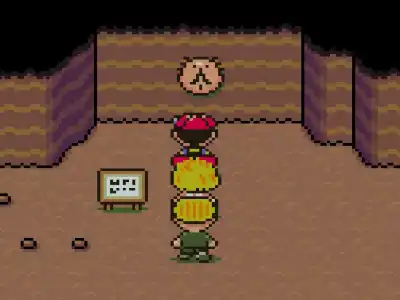
The Dungeon Man dungeon is a brilliant blend of critique and parody of JRPG game design.
…Brick Road.
Magicant
After defeating all 8 bosses at the Your Sanctuary locations and gathering the 8 melodies, Ness suddenly passes out and awakens in Magicant—the realm of his mind.
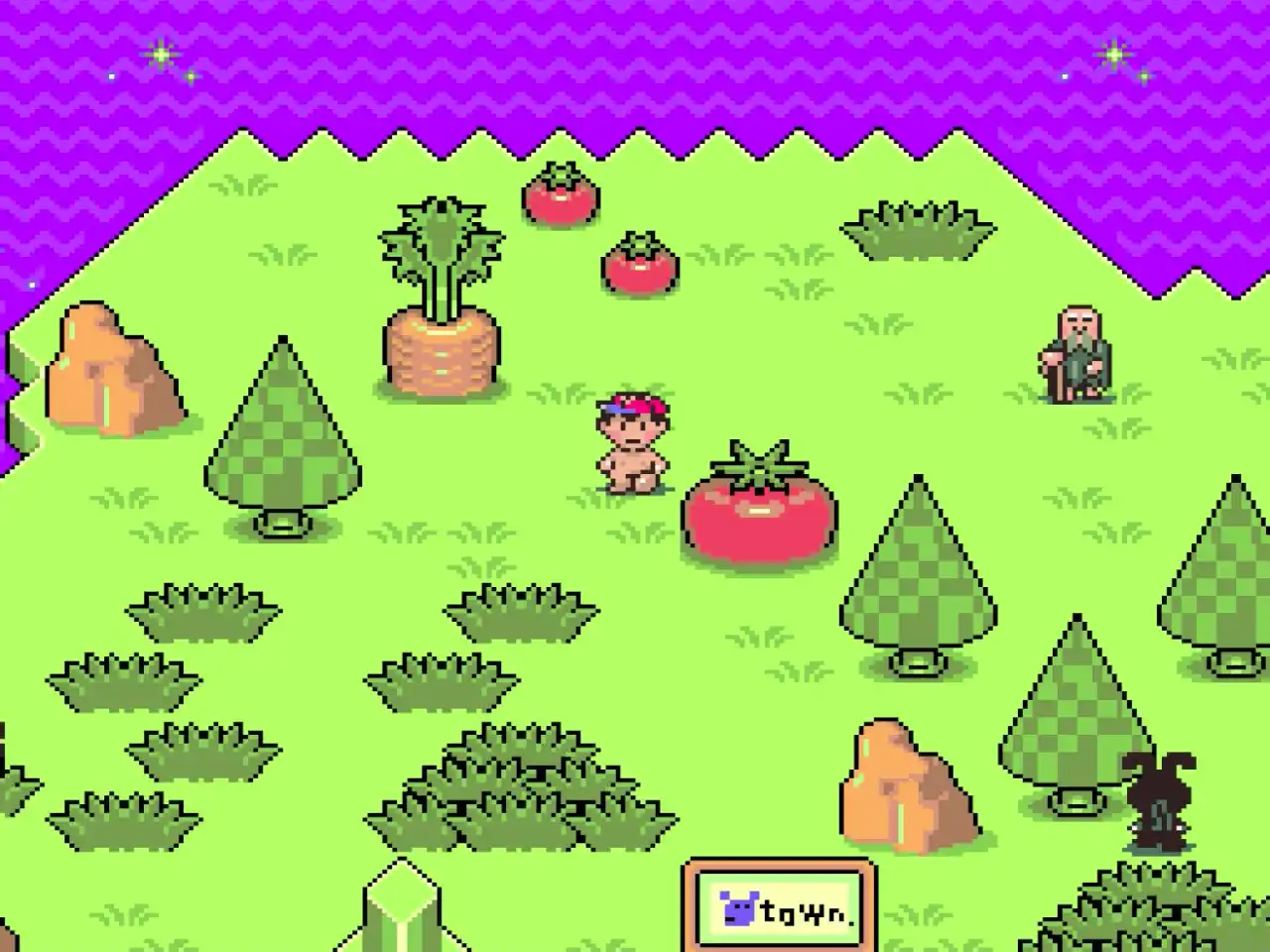
Magicant is a surreal place where reality and imagination blur. It’s filled with unique characters and elements representing different facets of Ness’s inner world. You encounter family members, Pokey, snowmen from the past, previously defeated enemies, and even a younger Ness, with whom you can have a poignant dialogue about the responsibilities of growing up at the expense of personal freedom and time. The Flying Men, representing Ness’s courage, can also be recruited to help with enemies.
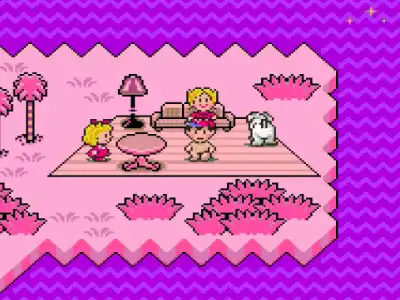
Magicant’s vibrant art and color palette reflect the depths of Ness’s psyche, showcasing his memories, fears, and hopes. The palette shifts after interacting with memories, representing changes in Ness’s emotions. The soothing, ethereal music enhances this experience, creating a sense of calm and wonder.
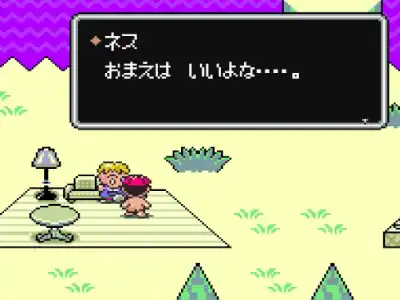
Ness’s journey through Magicant culminates in the Sea of Eden, a dark place within his subconscious, where he confronts his inner darkness and emerges stronger and more confident.
The Magicant section deepens our understanding of Ness, highlighting inner strength and self-awareness. Exploring Magicant is a personal experience, resonating on a profound level. It is a place of revelation and reflection, where the inward journey becomes as significant as the adventure itself.

Magicant in Mother 2 is a masterpiece of game storytelling, regarded as one of the highest points in video game narrative history.
Also, the Flying Man room music slaps hard.


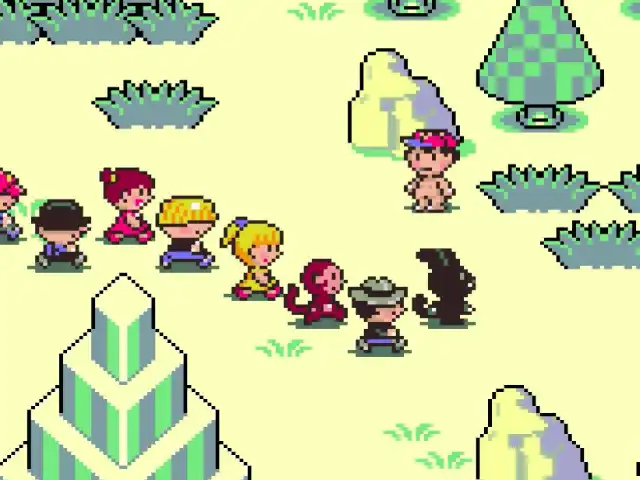
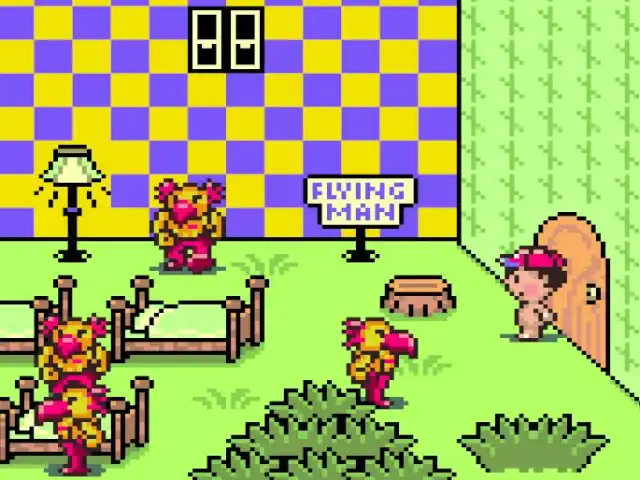
Love the Coffee/Tea Break Scenes
These breaks offer players a brief respite from the adventure to reflect on their journey. Filled with inspirational messages, they encourage perseverance and highlight the characters’ growth and progress.
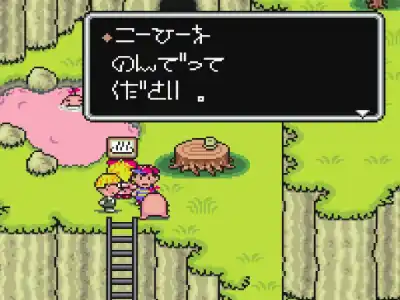
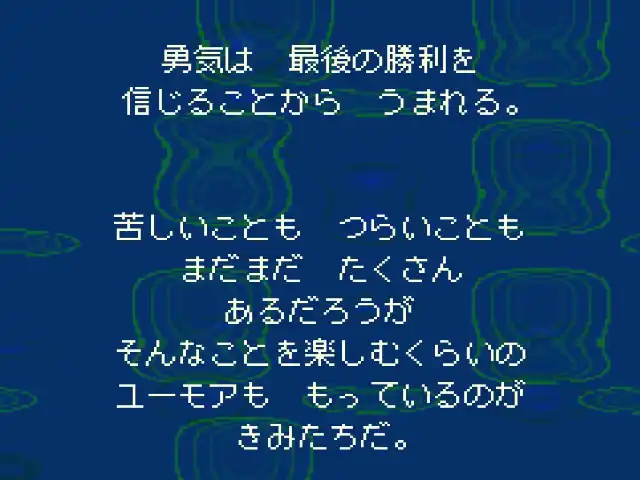
The soothing background music, combined with the gentle scrolling text, creates a peaceful and introspective atmosphere. It’s a unique storytelling device that reinforces the game’s themes of friendship, courage, and personal growth.
I remember reading somewhere that the narrator for these scenes is supposed to be none other than Shigesato Itoi himself, but I’m not really sure lol.

There are two breaks in total: the first is the coffee break in Saturn Valley, and the other is the tea break in Tenda Village.
The Final Showdown
WARNING
- This section contains spoilers about the end of Mother 2.
- It’s well worth experiencing it without spoilers if you haven’t beaten it yet.
The game maintains a mostly jolly tone until the final boss battle, where it takes a sharp turn into unsettling territory.
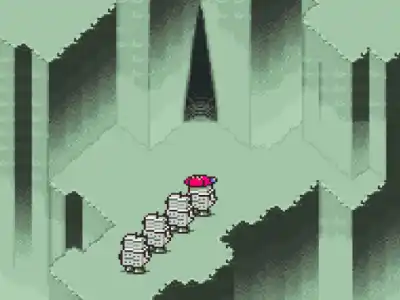
This shift is palpable as Ness, Paula, Jeff, and Poo arrive at the final dungeon where Giygas resides. The journey through the Cave of the Past, as the area is known, is filled with tough encounters, creating a mix of anticipation and dread as you approach the end.
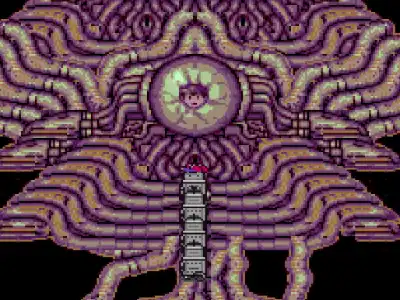
At the very end of the Cave of the Past, the party enters a grotesque, pulsating mass of intestine-like tubes—unlike anything encountered before. This nightmarish cave leads to the heroes’ final destination: a massive, unsettling machine, a disturbing fusion of organic and mechanical parts. Here, Ness is confronted by a familiar face: Pokey, now fully aligned with Giygas, riding a slick spider mech. Pokey smugly reveals that Giygas is encased in the Devil’s Machine, rendering it seemingly invincible.
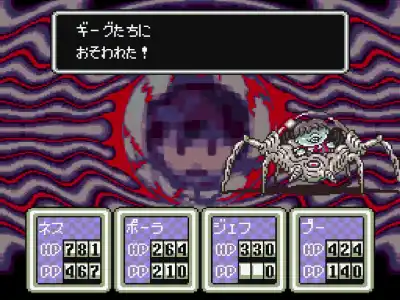
The battle begins with your party facing both Giygas and Heavily Armed Pokey. Giygas is invulnerable during this phase, so you focus on defeating Pokey. After inflicting enough damage, Pokey taunts Ness and turns off the Devil’s Machine, releasing Giygas in its terrifying, corrupted form. The screen goes dark, and the battle background morphs into a nightmarish, distorted red skull-like demon pattern.
Now able to damage Giygas directly, you find yourself in a grueling fight. Giygas’s attacks hit hard, and his dialogue—nonsensical and terrifying—reflects his complete descent into madness. The chaotic visuals and unsettling music amplify the sense of despair as you realize your attacks are becoming ineffective.
In a moment of desperation, you turn to Paula’s Pray ability, a mechanic largely overlooked until now. As Paula prays, a series of emotional cutscenes unfold, showing friends you encountered on your journey praying for your safety. These prayers are the key to damaging Giygas, as their combined hope and love begin to weaken it. The final, most powerful prayer comes from you, the player (the game lets you input your name), delivering the final blow to Giygas and ultimately defeating it.


This final battle is Mother 2’s most terrifying and emotionally charged moment. It defies the traditional JRPG finale by focusing not on raw strength but on the emotional connections between the characters and the power of hope and perseverance. It’s an unconventional and unforgettable experience that leaves a lasting impression long after the game ends.
Thematic Symbolism in Mother 2
Growing Up and Self-Discovery
At its core, Mother 2 is a coming-of-age story that explores the journey of growing up. Ness’s adventure is not just about saving the world but also about personal growth, courage, and self-discovery. As Ness travels from place to place, he faces challenges that represent stages of growing up—leaving home, making friends, and confronting fears. The Your Sanctuary locations could symbolize these stages, where Ness must reconnect with his childhood memories and fight his inner demons to gain the strength needed to defeat Giygas.

A poignant aspect of the game is the theme of family and homesickness, symbolizing the struggle of growing up and the importance of staying connected to your roots—the title Mother 2 kinda gives it away.
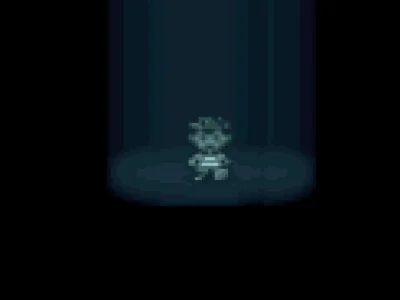
Sacrifice and responsibility play a significant role, as Ness must often make difficult choices for the greater good, highlighting the responsibilities that come with adulthood. For example, when Ness decides to leave his home and family to embark on a dangerous journey to save the world, he sacrifices the comfort and safety of his childhood for the greater good.
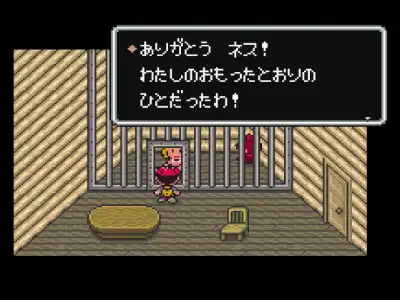
Ness’s journey is also filled with moments of courage and friendship, where he and his friends rely on their bonds to overcome obstacles, emphasizing the importance of mutual support in life’s challenges.
The game is also rich with nostalgia and memories, from the photographic snapshots to the Sound Stone melodies, underscoring the importance of cherishing the past while moving forward.
In essence, Mother 2’s multi-layered narrative resonates with players, reminding us of the universal journey of growing up and the complexities that come with it. The story evokes emotions and reflections on themes like family, courage, and the passage of time, making it a timeless experience that continues to connect with audiences across generations.
The Moonside of Wealth: Power and Money’s Influence on Society
Mother 2 explores the darker aspects of society through its exploration of money, greed, power, and corruption. The Mani Mani Statue—a mysterious golden statue that manipulates the minds of those who encounter it—serves as a central symbol of these themes, embodying the destructive nature of greed and the corrupting influence of power.
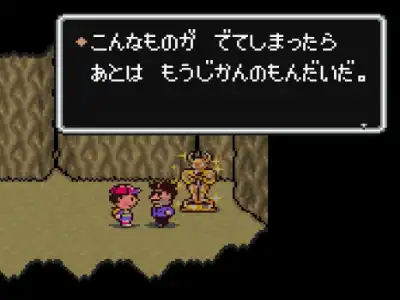
This theme is vividly illustrated in the game’s portrayal of Happy Happy Village, where people are brainwashed into a cult that demands money for entry. The Runaway Five’s perpetual debt, Monotoli’s corruption, and even the constant need to pay for services like hotels and hospitals further emphasize how money permeates every aspect of life, often leading people astray.
Mother 2 subtly suggests that while money is an inevitable part of growing up, it’s crucial not to let it corrupt you—a message reinforced by the adults who fall under the statue’s influence. This exploration of greed and corruption adds depth to the narrative, making Ness’s journey not just a personal quest but also a broader commentary on the impact of societal pressures and the dangers of unchecked power.
The Power of the Mind
PSI powers in Mother 2 represent the mind’s strength and the transformative power of thought.
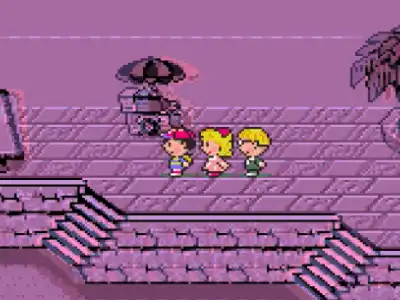
The game explores these themes most notably through Ness’s journey in Magicant, a realm within his mind where he confronts his deepest fears and memories. This journey parallels practices like meditation and mindfulness, emphasizing the importance of introspection and mental clarity. At the end of Magicant, when Ness defeats his inner evil, he receives a significant power boost, symbolizing the immense strength gained from self-confrontation and personal growth.
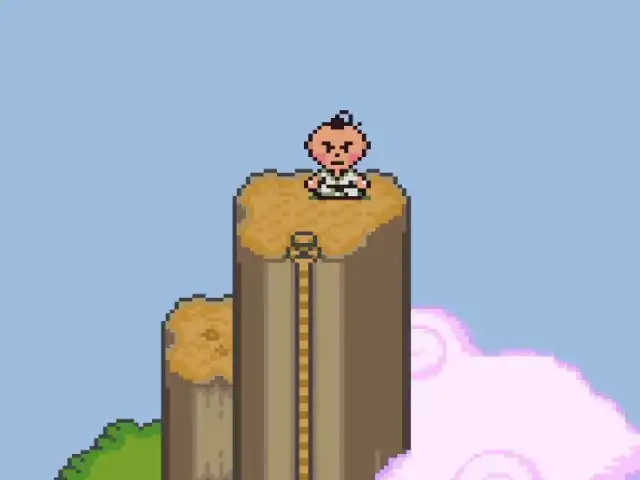
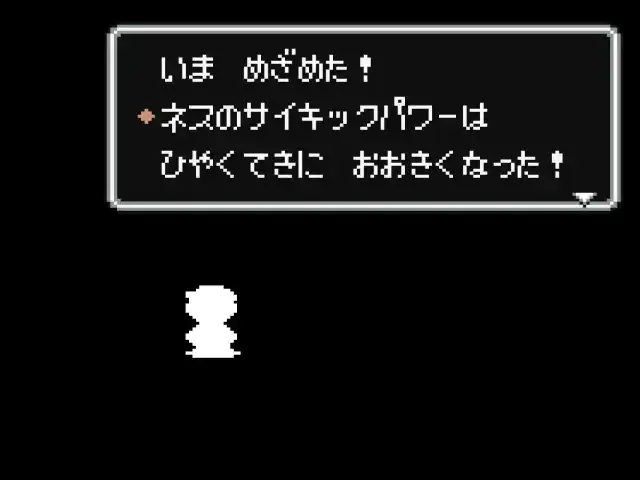
Mother 2 highlights how the mind, when fully harnessed, can achieve remarkable feats.
Relationship Between Ness and Pokey

Pokey is on a parallel journey to Ness’s, serving as a dark mirror to Ness’s heroic quest. While Ness grows in strength and virtue, Pokey descends further into selfishness and villainy, underscoring the divergent paths the two characters take.
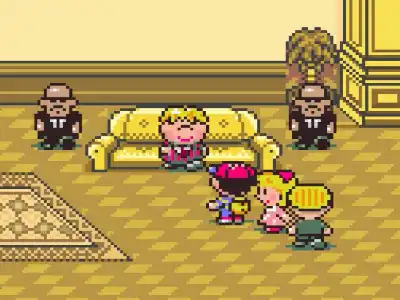
Pokey’s actions play a crucial role in the game’s events, particularly when he releases Giygas from the Devil Machine, inadvertently making Giygas vulnerable and leading to his eventual downfall. This twist highlights the unpredictability of Pokey’s character and the unintended consequences of his actions.

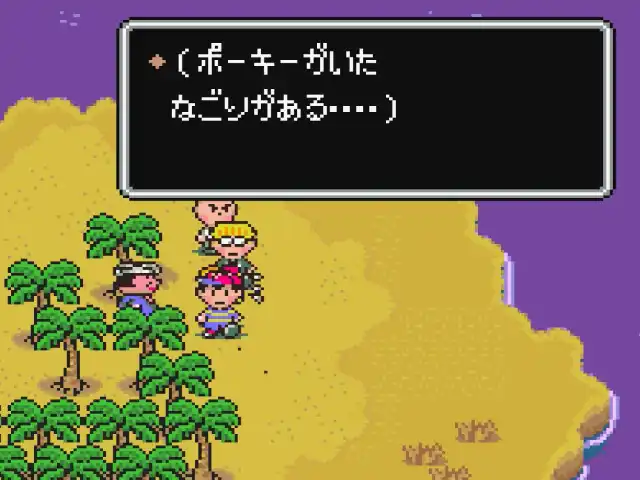
It’s a dynamic relationship with layers of complexity, making Pokey and his interactions with Ness something I’d love to explore in a separate blog post.
So is Mother 2 the Perfect Game?
Pretty much. However, the game is not without its minor issues.
The inventory/shop/pickup storage service is clunky, with reordering inventory and lack of item stacking being particularly cumbersome. Jeff’s reliance on items during battles exacerbates these inventory management problems. Players are forced to hang onto many key items, and it’s not always clear when they can be stored, making accessing storage cumbersome. Escargot Express—an in-game service that picks up and stores items for you—is helpful but clunky to use because it’s limited to three items per trip and costs money.
While the battle system is very fun, and Jeff’s special command is quite useful, Paula and Poo’s moves feel kinda useless most of the time. The battle system also lacks battle cursor memory functionality, which would have streamlined combat by remembering your last action.
Poo’s character feels somewhat shoehorned into the story compared to other party members, making him join the party seem less organic.
The game is not always straightforward in guiding players on how to proceed, especially compared to modern JRPGs, but that’s more a reflection of Mother 2 being a product of the 90s rather than an innate flaw.
Despite these issues, Mother 2 remains a highly enjoyable game.
Mother Two? Does it Mean There are Other Games in this Series?
Mother 1
Mother 1 , originally released in Japan for the Famicom in 1989, served as the foundation for the Mother series. However, it wasn’t until 2015 that the game was officially released in English as EarthBound Beginnings for the Wii U Virtual Console.
The game tells the story of Ninten, a young boy on a mission to save the world from an alien invasion led by Giygas—yes, the same Giygas who later returns as the main antagonist in Mother 2.
While Mother 1’s gameplay may feel dated to some, it remains an enjoyable and significant experience for fans of the series.

Mother 3
Mother 3 , the final entry in the Mother trilogy, was released exclusively in Japan in 2006 for the Game Boy Advance. It follows Lucas and his ragtag party of friends on a quest to save their world from a mysterious threat.
Despite critical acclaim, Mother 3 has never been officially localized in English or any other language outside of Japanese, though a fan translation exists.
While the order of play doesn’t impact understanding, experiencing the games sequentially can deepen your appreciation for the series’ evolution. Both Mother 1 and Mother 3 have unique merits and are worth playing before or after completing Mother 2.
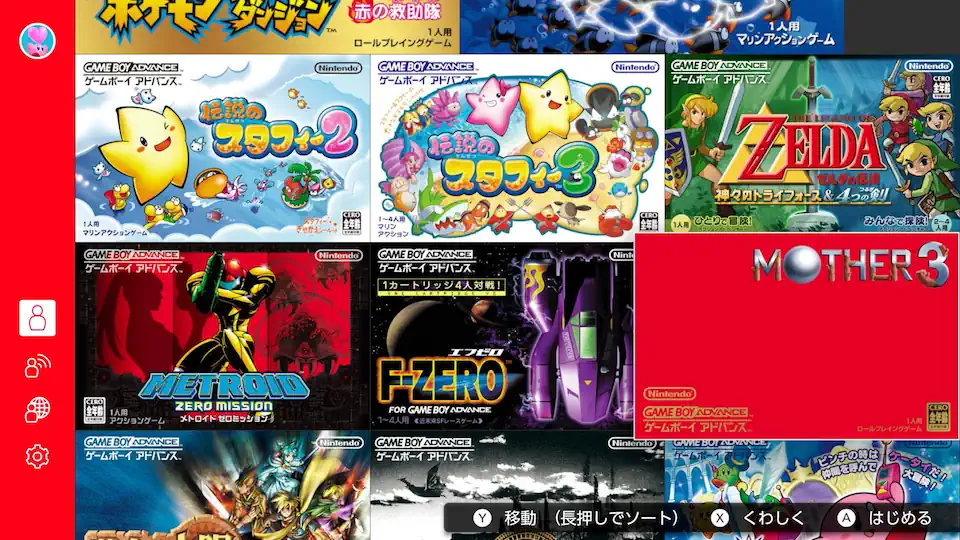
Mother 2: In Conclusion
Replaying Mother 2 throughout the years and twice from start to finish before writing this article, I find that each playthrough reveals new details and offers fresh enjoyment, making every experience unique. The charm and depth of the game continue to resonate, making it a beloved classic.
This game speaks to you differently depending on where you are in your life journey. It captures the spirit of 90s kids on a grand adventure, beloved worldwide. It starts with humor but evolves into a deeply emotional journey—come for the laughs, stay for the tears.
Despite being 30 years old, Mother 2 remains timeless. I highly recommend playing it if you haven’t yet.
Happy 30th anniversary, Mother 2!
Bonus: Mother 2 no Himitsu - Satellite Ten (Tobichi Tokyo)
The “MOTHER2 no Himitsu - Satellite Ten” event was held at Tobichi Tokyo, the official Hobonichi shop located on the first floor of the Hobonichi office in Kanda, Tokyo.
The event showcased selected replicas of development materials (no pics allowed tho) from Mother 2. While the main exhibit took place at Shibuya Parco, this satellite event focused on the sale of new and exclusive Mother merchandise. In addition to the development materials, special displays of the original clay figures from the game’s instruction manual were also featured.
The Tobichi Tokyo satellite exhibit ran from August 1 to August 18, 2024.
Hobonichi Kanda Building
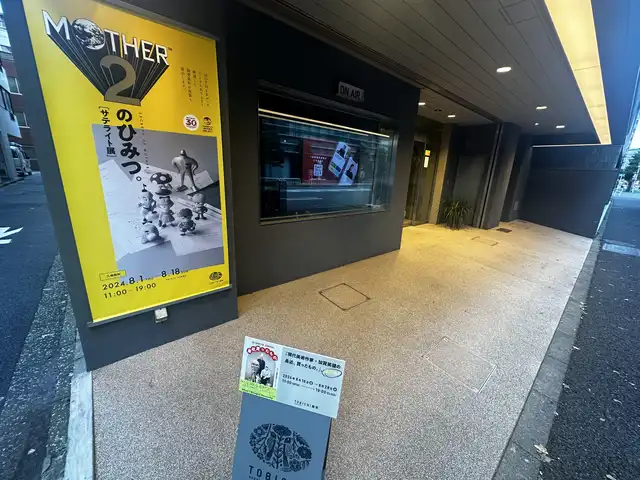
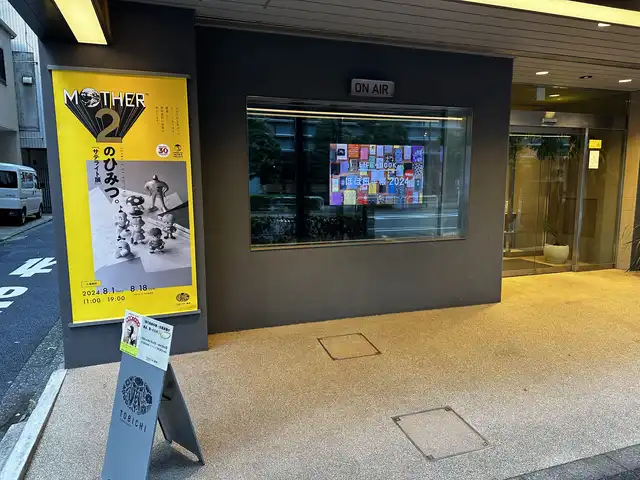
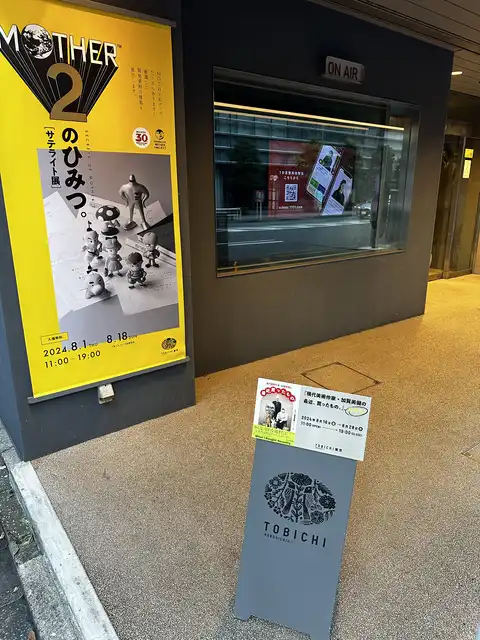



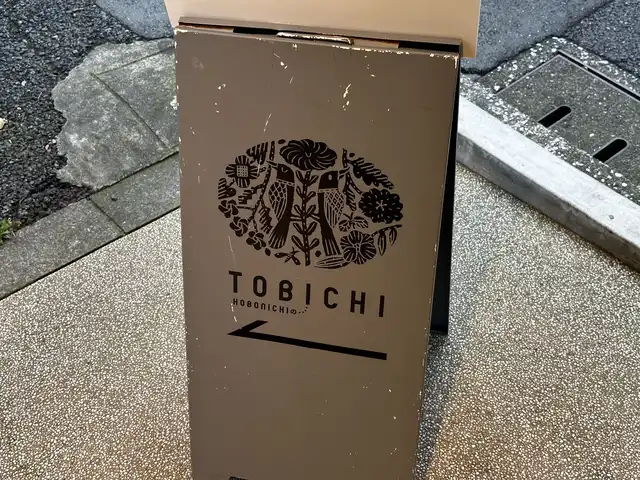
Entrance

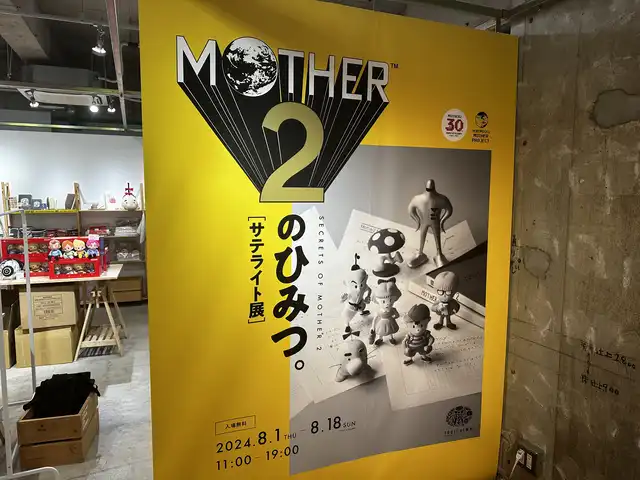

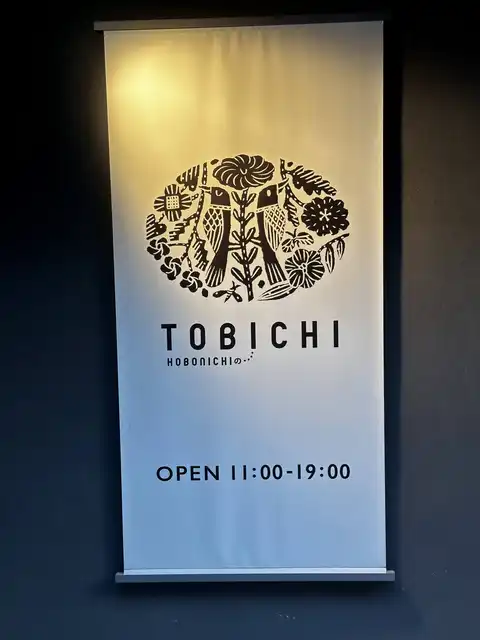
Starman Statue


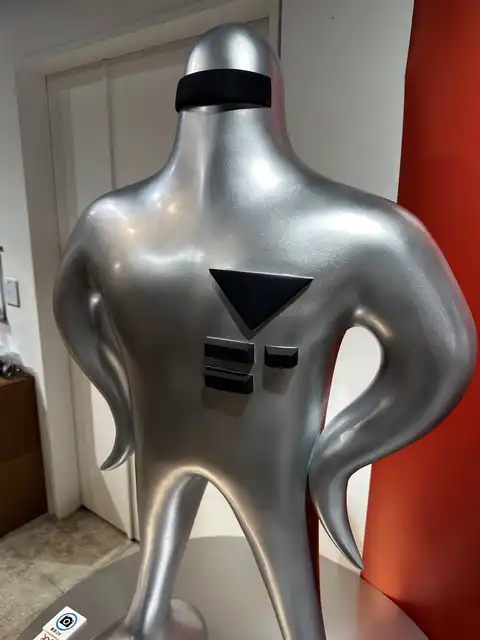

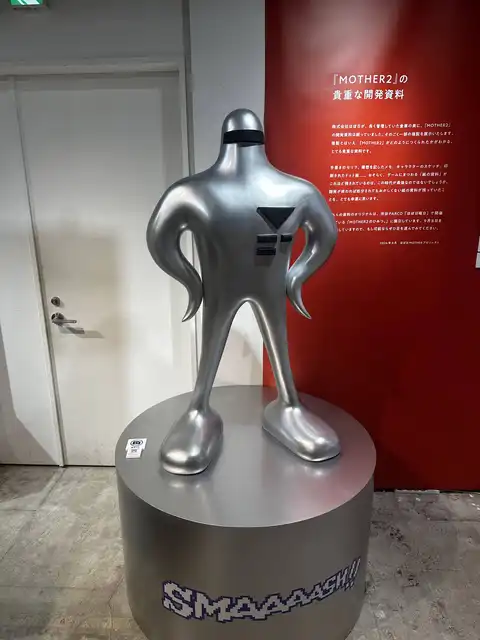
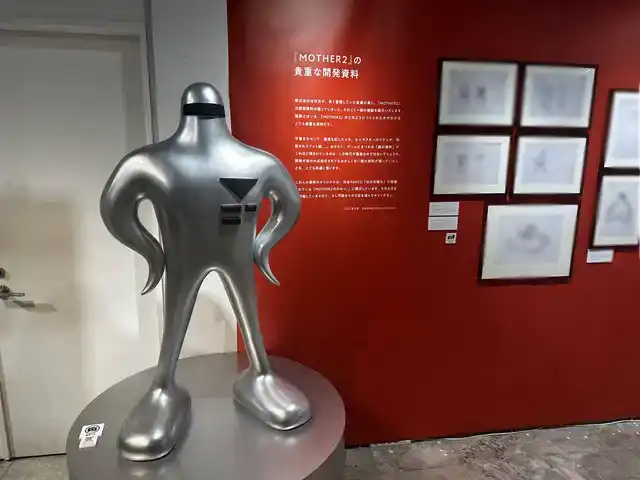
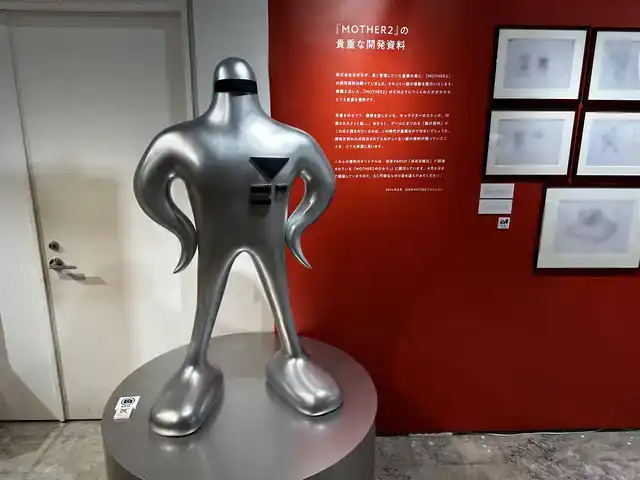
OG Clay Figures
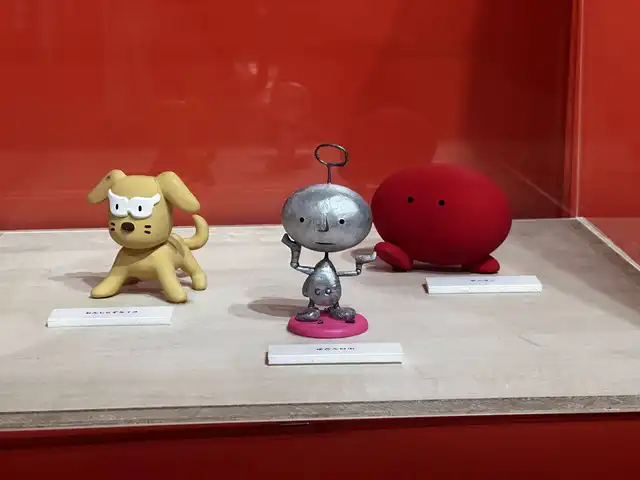
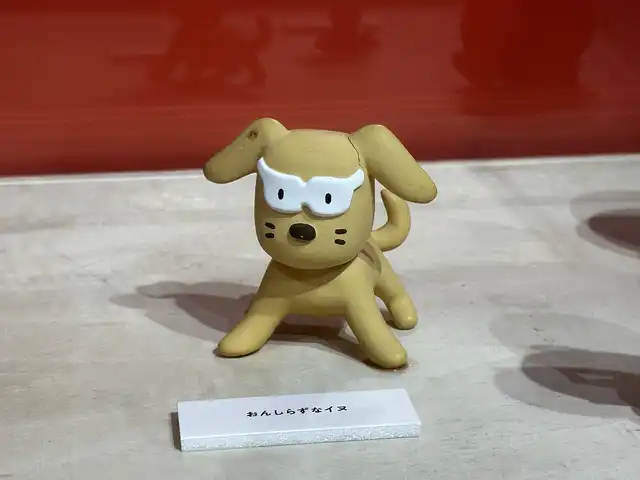
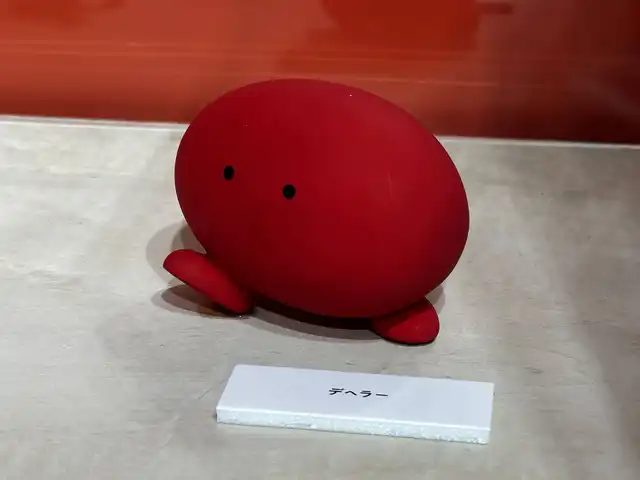

Special Edition Soft Vinyl (Sofubi) Action Figure of Ness
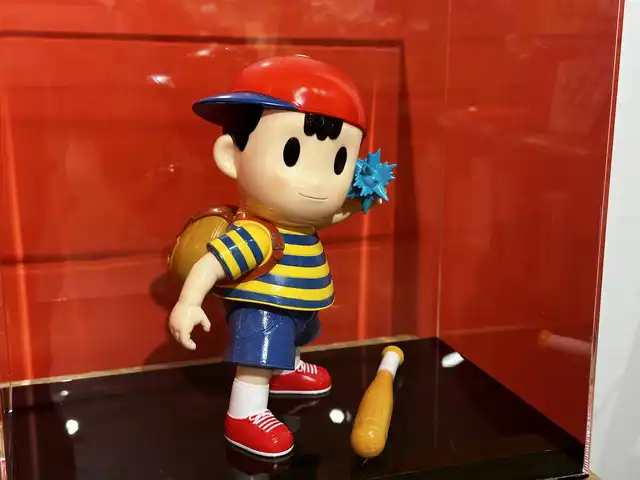
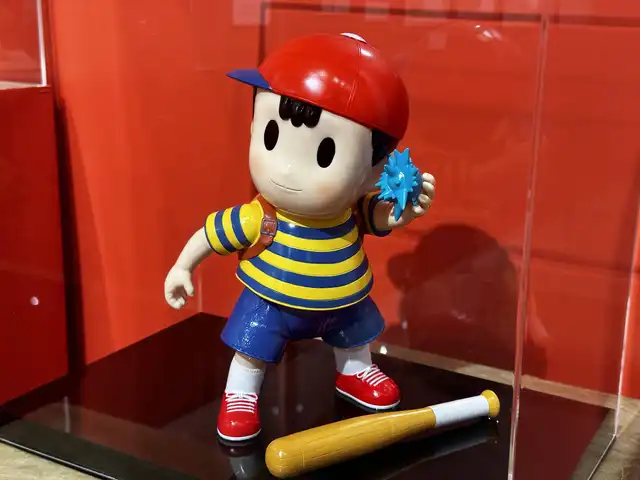
Magnet Plushies Wall


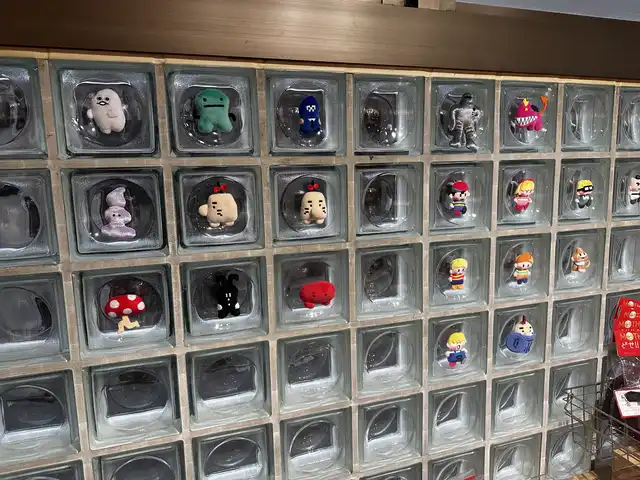
Mr. Saturn Plushies
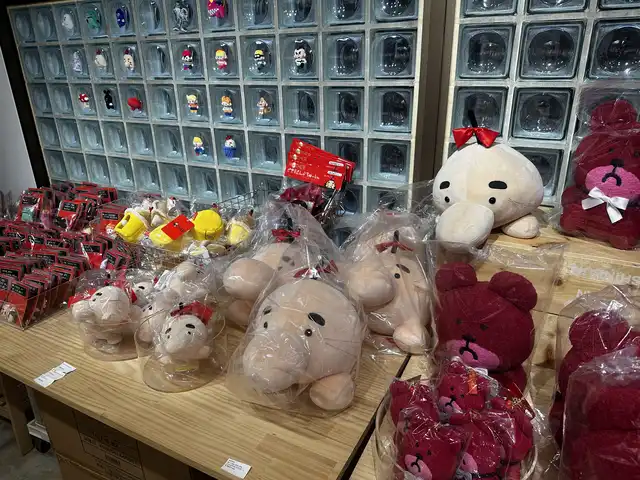
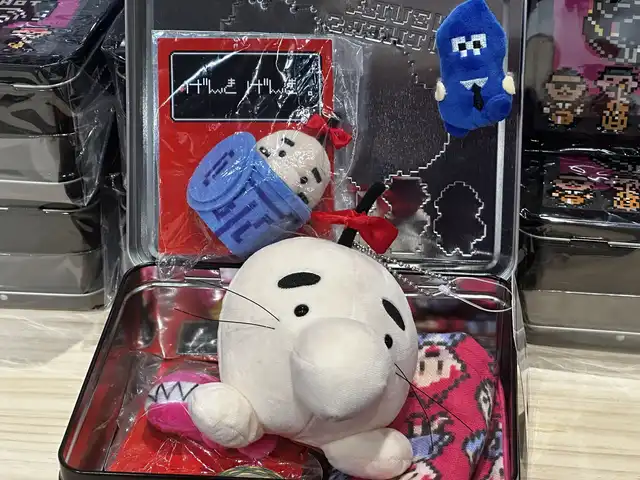
Can Badges

Hobonichi Techo 2025
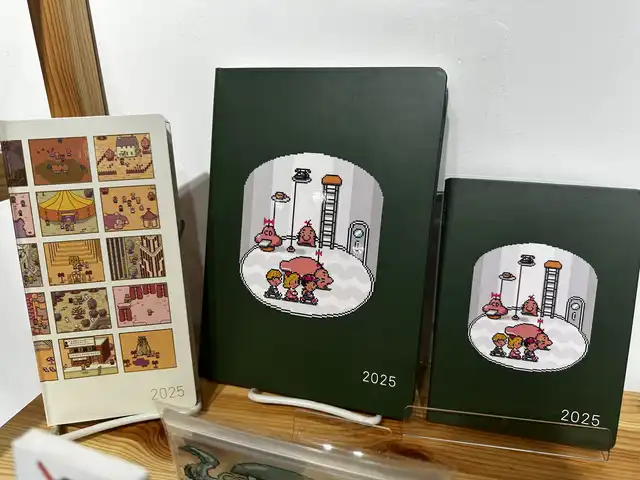

Mother 2 Plushies
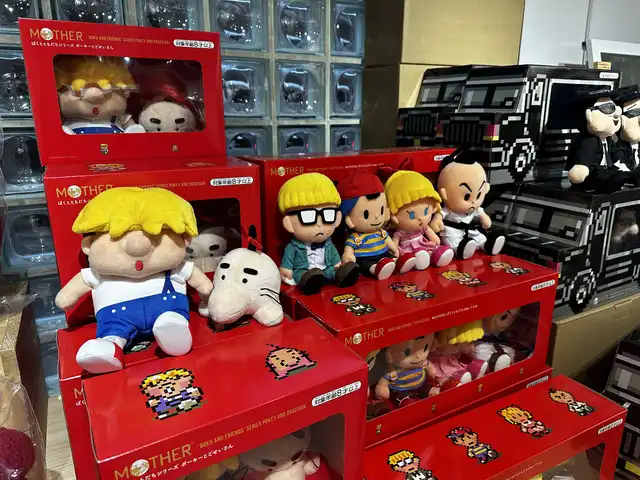
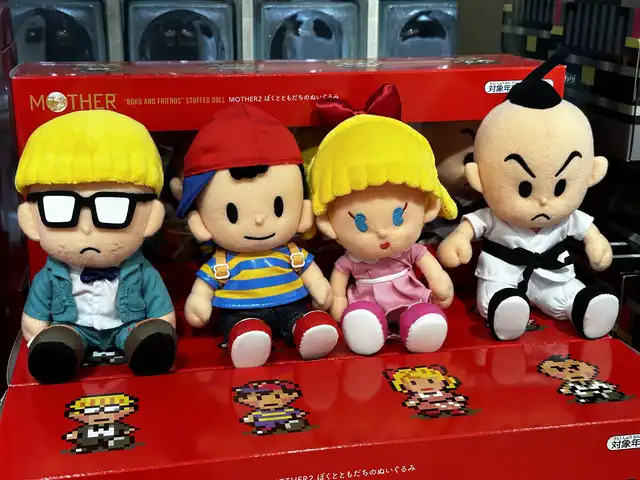


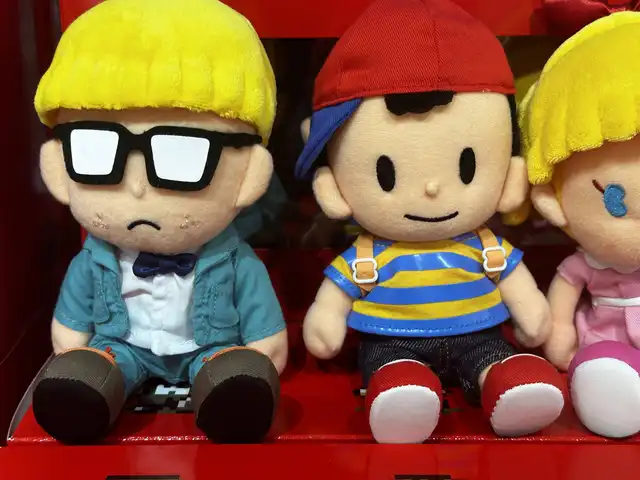
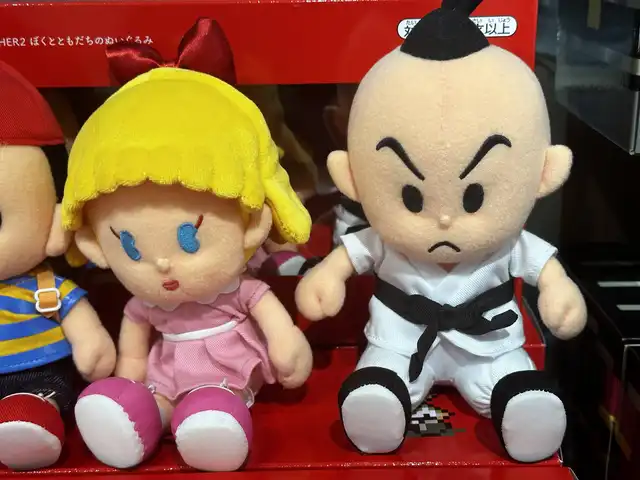



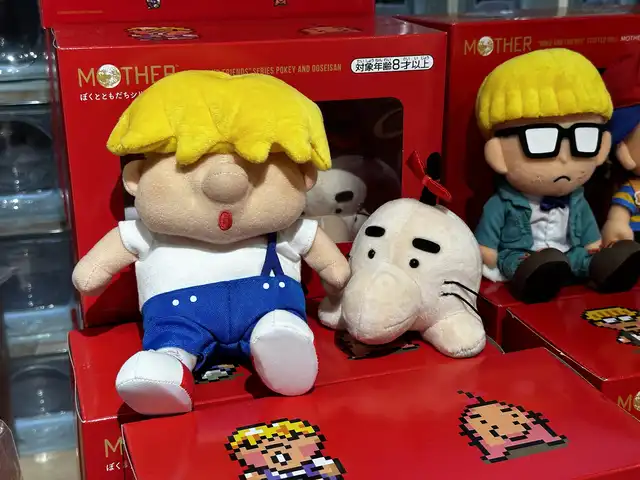
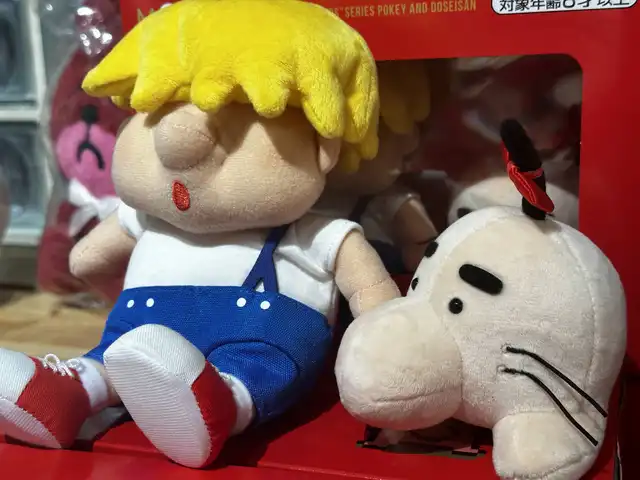
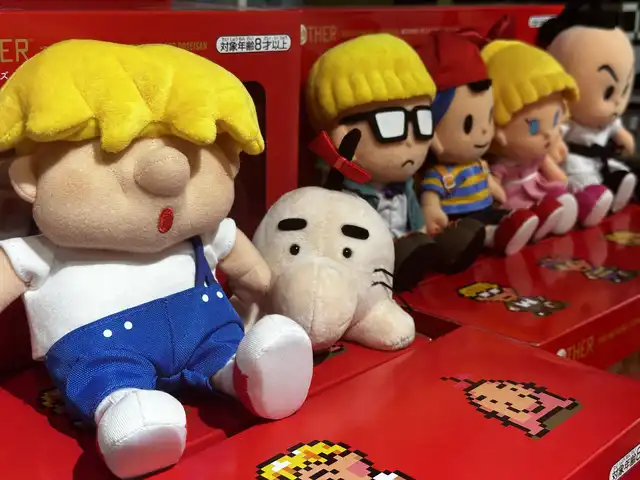
Mother 3 Plushies

Phase Distorter Pouch

Hobonichi Techo + Hobonichi Books

